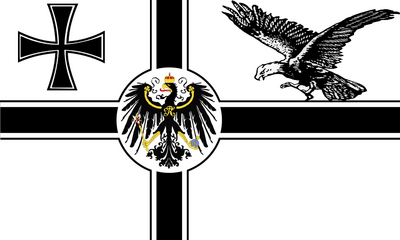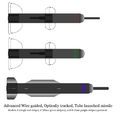Imperial Air Force of TECT
| The Imperial Air Force of TECT | |
|---|---|
 Flag of the Imperial Air Force. | |
| Active | 1917AD – Present |
| Country | |
| Allegiance | TECT |
| Type | Air Force |
| Size | 2,000,000 |
| Part of | TECT Armed Forces |
| Nickname(s) | IAF, Imperial Eagles. |
| Patron | GEN Baumgartner |
| Motto(s) | "Fly high, Dive low, Land Softly." |
| Colors | White and Gray |
| Mascot(s) | Heilige Wald Bald Eagle. |
| Commanders | |
| Secretary | Abraham Acker |
| Vice Secretary | Rüdiger Westerberg |
| Chief Officer | Evert Langenberg |
The Imperial Air Force of TECT or IAF for short, is a military branch of the TECT Armed Forces responsible for aerial warfare, air services, and a number of ongoing strategic missile programs; a number of other services includes research, cyber warfare, air support, maintaining security and law enforcement of TECT Airspace, and projecting the Empire's air power abroad. Charged with protecting TECT's air territory, the Imperial Air Force possess cutting edge jet fighters, ground attack aircraft, and long range bombers capable of reaching other continents. Placed in charge of aerial training, the IAF is responsible for hosting training centers for both Imperial Army and Royal Guard Marine aviation branches; IAF as a branch also provides a wide range of logistical support in the form of strategic flights, cyber command operations, and dual-runs the Department of Defense's (a department under the Ministry of The Armed Forces) Strategic Airborne Shield program. The Imperial Air Force, as the leading military branch for the SAS program, commands a series of detection and tracking facilities, command centers, response units, and the network of anti-air/missile shields located all over the Empire. Other authority given to the branch by the government includes command over the Empire's space program, air traffic control administration, control over the MOAF's cyber command, and operation of TECT's nuclear deterrent in the form of static ICBM stations. To achieve its goals the IAF possess an enormous fleet of various aircraft, a wide range of facilities all over the world, and continuously advances in aerial warfare technology.
Founded in late December of 1917, the Imperial Air Force is the youngest branch in the TECT Armed Forces after it was separated to form its own military branch under then Ministry of the Military (MOM). The formation of the branch came about the same time biplanes became popular use in many countries' military forces. TECT was behind in the game still using mostly blimps to engage in bombing operations. This was until years prior that biplanes from an opposing hostile nation shot down a large number of the Imperial Army's blimps - the incident is still widely remembered as an embarrassment for the TECT military. Learning from this mistake, the MOM decided it was time to invest in the Empire's aerial warfare capability - the first step was introducing the Imperial Air Force as its own military branch. Although not without a fight from the Imperial Army, the Imperial Air Force was founded in 1917 as it welcomed brand new models of biplanes into its service. As time flowed on and technology changed, the IAF gradually slipped into a more simple state of armed readiness that focused on protection and projection - having a capable amount of fighters based at home to defend the mainland while having bombers that can travel to other continents for attacks - the Imperial Navy was left in control of many fighter and attack aircraft roles. During the 1970's the Imperial Air Force shifted to a more modern approach seeing as new technology meant changing with the times - this included an air force with modern fighters and not focusing solely on defense and the introduction of new aircraft capabilities. Strategic missiles were also introduced under the IAF as it managed the Empire's ICBMs and missile research. The Imperial Air Force has since kept a steady approach in terms of simplification, modernization, and technological innovation.
Modern Air Force
The modern organization of the Imperial Air Force is made up of Defense and Expeditionary units positioned in Command Theaters of Operation (CTO). These CTOs are Northern Command, Eastern Command, Western Command, and Southern Command; each Command usually follows State lines but in some occurrences they split States in half or portions of States from another Command. Eastern and Western Commands are larger then Northern and Southern Commands due to their vast coverage of each coast - so while Northern and Southern Commands are home to a single Command element, Eastern and Western are home to more Command sized units. Although the vast size of the Imperial Air Force uses Defense and Expeditionary units that are reservists, actual unit sizes vary from two Wings to around six or eight. The primary organizations inside the IAF are Flights, Squadrons, Wings, Air Divisions, and Commands.
| Pay grade | O-1 | O-2 | O-3 | O-4 | O-5 | O-6 | O-7 | O-8 | O-9 | O-10 | Special ¹ |
|---|---|---|---|---|---|---|---|---|---|---|---|
| Insignia | |||||||||||
| Title | Second Lieutenant | First Lieutenant | Captain | Major | Lieutenant Colonel | Colonel | Brigadier General | Major General | Lieutenant General | General | General of the Air Force |
| Abbreviation | 2d Lt | 1st Lt | Capt | Maj | Lt Col | Col | Brig Gen | Maj Gen | Lt Gen | Gen | GOAF |
|
No periods are used in actual grade abbreviation, only in press releases to conform with AP standards. | |||||||||||
| TECT Code | O-1 | O-2 | O-3 | O-4 | O-5 | O-6 | O-7 | O-8 | O-9 | O-10 | |
| |||||||||||
Fighters
- Bartgeier V2C4.png
The Bartgeier Multirole Fighter. Info.
Ground Attack/Bombers
- RM-30.jpg
The RM-30 strategic supersonic bomber. Info.
- GAP Dragon.jpg
Ground Attack Plane Dragon. Info.
Transports
- SA-95 Taube Strategic Transport Plane C6.png
The SA-95 Taube. Info.
- TA-06 Kolibri C6.png
The TA-06 Kolibri. Info.
Command/Support Craft
- Global Eye AWACS(1).png
Global Eye AWACS/Battlespace Command. Info.
- T565 Modular Tanker.jpg
The T565 is a heavy resupply gas tanker. Info.
Electronic Warfare
Helicopters
- Kondor Mulitrole Helicopter V2C2.png
The Kondor Utility Helicopter. Info.
- HLT Adler Helicopter V2C3.png
The HLT Adler Helicopter. Info.
- Anakonda Attack Helicopter V2C4.png
The Anakonda attack helicopter. Info.
Unmanned Arial Vehicles
- Blackfly UAV.png
Blackfly multirole UAV/UCAV.
Missile & Other Ordinances
'Speer' Anti-Tank Guided Missile family. Info.
ALOT ATGM Series. Info.
- Slingshot SAM.jpg
Slingshot "New Age" Surface-to-Air Missile family. Info.
- SSM-7 Comparison.png
SSM-7 Mk. 1 & 2 'Mary Sue & Blue' (C model) ASM. Info.
- Lanze LRSAM E1.png
Lanze Long Range Surface-to-Air Missile System. Info.
- Komet Side-By-Side 2.png
Komet BVRAAM (A and GLAAM models). Info.
- Spatz Autonomous Smart Submunition.png
Spatz Autonomous Smart Submunition (SASS). Info.

